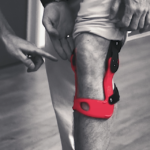Biomechanical effect of unloader braces for medial osteoarthritis of the knee
Osteoarthritis (OA) is a frequent cause of knee pain, especially in the elderly population. The prevalence of OA is expected to increase as the population ages. The initial treatment of OA is non-operative and consists of patient education, weight reduction, physical therapy, and pain relieving medication.

OssKin Evoke
In knee joints with varus malaligement, the ground reaction force vector runs medially and from the middle of the knee baseline. The moment arm is the perpendicular distance between the ground reaction force vector and the knee’s center of rotation. This moment arm produces an external adduction moment, also named varus moment. The knee adduction moment has been identified as the mechanism primarily responsible for the increased compressive load on the medial compartment of varus knees. A large adduction moment shifts the weight bearing line medially within the knee and leads to increased medial compartment loading.
Consequently, especially in unicompartimental OA, knee alignment plays an important role for disease progression and functional decline. Besides the possibilities of surgical axis correction procedures, non-surgical interventions for unicompatimental OA are knee braces which may alter the alignment of the lower extremity. These so-called unloader braces apply an external varus or valgus force to the knee to shift loads towards the non-affected compartment, (e.g. the external valgus force acts via condylar pads or straps while opposing counterforces which arise from the supports proximal and distal to the knee joint). Due to the high prevalence of medial OA, valgus bracing is used more frequently than varus bracing.
Randomized controlled trials (RCT) could confirm that in patients with medial OA and varus malalignment knee bracing—in comparison to non-treated patients—results in improved knee function. However, there is still a debate about the exact biomechanical effect of unloader braces.
For example, Horlick and Loomer found no significant influence of an unloader brace on the femoral-tibial angle or joint space. In contrast, Komistek et al. demonstrated significant condylar separation of the medial compartment with the use of valgus bracing. These conflicting results may result from differences in study or brace design.
The goal of this article was to perform a systematic literature review of biomechanical studies investigating the effect of unloader braces. Because of its biomechanical significance, particular attention was given to the reduction of the adduction moment. Regarding the outcome, we hypothesized that unloader braces are able to reduce the adduction moment of the knee.
| References |
Valgus Knee Bracing for Medical Gonarthrosis, Horlick, Simon G. BSc, MD; Loomer, Richard L. BA MD. Clinical Journal of Sport Medicine 3(4):p 251-255, October 1993.
| Further reading |
Biomechanical effect of unloader braces for medial osteoarthritis of the knee: a systematic review (CRD 42015026136), Wolf Petersen, Andree Ellermann, Thore Zantop, Ingo Volker Rembitzki, Hartmut Semsch, Christian Liebau, and Raymond Best. Arch Orthop Trauma Surg. 2016; 136: 649–656. Published online 2016 Jan 6. doi: 10.1007/s00402-015-2388-2
Unloader braces for medial compartment knee osteoarthritis: implications on mediating progression, Ramsey DK, Russell ME. Sports Health. 2009 Sep;1(5):416-26. doi: 10.1177/1941738109343157. Full text, PDF
Also see
Treatment of Osteoarthritis of the Knee, 2nd edition, summary of the AAOS clinical practice guideline






